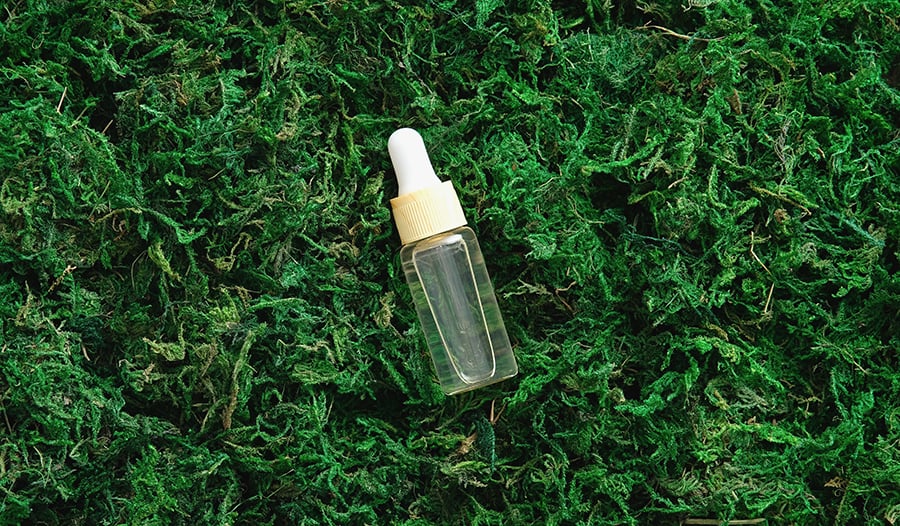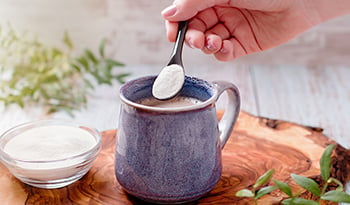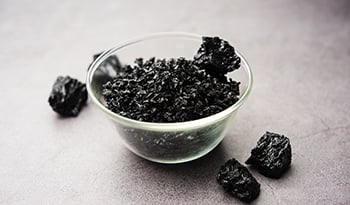What Are the Benefits of Sea Moss?
DISCLAIMER:This blog does not intend to provide diagnosis...
- In this article:
- What Is Sea Moss?
- Potential Benefits of Sea Moss
- Potential Sea Moss Side Effects
- Takeaway

What Is Sea Moss?
Sea moss, known scientifically as Chondrus crispus, is a type of seaweed commonly found in the coastal regions of the Atlantic Ocean along the North American and European continents. Sea moss can also be found in the Pacific Ocean but is less common.
Sea moss is categorized as a red seaweed, distinguishing it from other seaweeds that may be categorized as green or brown. It has a spiny appearance and a slimy texture. Sea moss is also called red seaweed or Irish moss.
Outside the health and wellness sphere, sea moss is primarily used as a source of carrageenan. Carrageenan is a thickening agent used in various commercially produced foods like jellies, yogurt, and ice cream. Carrageenan is also found in certain medications. While sea moss may be a source of carrageenan, its potential health benefits expand beyond just thickening foods.
Potential Benefits of Sea Moss
1. Sea Moss May Be High in Health Promoting Nutrients
When it comes to nutrients, sea moss may pack a powerful punch. Studies show that sea moss contains various vitamins and minerals essential for the body to function optimally. For example, one study found that sea moss contained more calcium than milk.
As a member of the Rhodophyta or red seaweed division, sea moss has also been found to have higher amounts of potassium, manganese, and zinc than green seaweeds and is also rich in iodine.
Potassium is necessary for healthy blood pressure, while manganese supports the breakdown of carbohydrates into energy. Zinc plays a huge role in supporting a healthy immune system, while iodine is essential for thyroid health.
Studies also suggest that sea moss contains beta-carotene, a yellowish compound converted to vitamin A in the body. Studies link optimal levels of beta-carotene in the blood to less risk for cardiovascular disease. In comparison, vitamin A intake is associated with optimal eyesight and less risk of night blindness.
In addition to vitamins and minerals, studies indicate that sea moss may contain a small amount of protein. One study found that the dry weight of sea moss contained an impressive 35% protein, but this percentage may have been increased due to how the sea moss was prepared. Studies suggest that the protein content in sea moss may vary depending on the way the sea moss is processed.
According to the United States Department of Agriculture (USDA) FoodData Central Database, 10 grams or 2 tablespoons of sea moss contains approximately 0.2 grams of protein.
2. Sea Moss May Support Thyroid Health
Since sea moss, like many other seaweed, is rich in iodine, research suggests that sea moss may benefit the thyroid. The thyroid is a butterfly-shaped gland at the base of the neck responsible for regulating the metabolism and development of the body.
To function properly, the thyroid requires optimal iodine intake through the diet. Once ingested, iodine is used to create thyroid hormones, which play various crucial roles in the body, like supporting healthy weight and helping maintain a normal body temperature.
One study focused on 8 Inuit individuals in the Arctic who consumed sea moss at least weekly. The study found that the iodine in sea moss was highly bioavailable, which may contribute to thyroid health.
Another study involving 44 individuals found that a thyroid stimulating hormone or TSH was within the normal reference range for individuals, albeit on the higher end.
TSH is a hormone secreted by the pituitary gland in the brain that tells the thyroid to start making more of its own hormones triiodothyronine (T3) and thyroxine (T4). A higher-than-normal TSH means that there may be some thyroid dysfunction.
The study noted that those individuals with TSH in the higher range of normal consumed more sea moss than typical and consumed it daily.
3. Sea Moss May Improve Gut Health
A properly functioning gut is one of the most important pillars of overall health and wellness. Sea moss may be of benefit to gut health.
Studies suggest sea moss is high in gut-healthy nutrients like dietary fiber and oligosaccharides. Oligosaccharides are a type of carbohydrate that is indigestible by the human body. This allows the oligosaccharides to pass through the upper digestive tract, like the stomach, to enter the gut and become food for healthy bacteria. Essentially, oligosaccharides act as prebiotics for the gut.
One animal study found that supplementing with sea moss was associated with more beneficial bacteria growth in the gut than the group that did not receive supplementation.
The study also found that not only did beneficial bacteria increase, but harmful bacteria decreased. Furthermore, the study found an increase in certain antibodies, indicating that sea moss may help support the immune system.
4. Sea Moss May Benefit Skin Health
Glowing flawless skin is often a coveted sign of health. Research suggests that one of the benefits of sea moss may be promoting healthy skin. One study analyzing the nutritional contents of sea moss found that the seaweed contained citrulline-arginine.
Citrulline-arginine is a molecule containing the amino acids citrulline and arginine. Citrulline is a non-essential amino acid that is converted into arginine by the kidneys. Arginine is an essential amino acid for children but not for adults and is primarily used by the body for the synthesis of new proteins and immune support.
Studies suggest that arginine may promote skin health by decreasing wound healing times and increasing the protein content in the skin.
Sea moss may also benefit skin health because of carrageenan. While there is controversy surrounding carrageenan ingestion, one test-tube study suggested that carrageenan may protect against ultraviolet B-induced skin cell damage.
Another test-tube study indicated that the carrageenan found in sea moss acted as an antioxidant and helped to protect cells from damage.
5. Sea Moss May Enhance Brain Health
With aging, many individuals seek to maintain a healthy, active body and a sharp brain. Studies indicate that sea moss may benefit brain health.
One animal study focused on the effects of sea moss on Parkinson’s disease. Parkinson’s disease is a condition in which brain cells that produce dopamine are damaged. This causes the body to undergo stiffness, tremors, slow movements, and other uncontrollable body movements.
The study involving an animal model of Parkinson’s disease found that supplementing with an extract of sea moss helped to prevent the loss of brain cells that produce dopamine.
The study noted that the sea moss extract supplementation was associated with quicker movements. The study also found that sea moss extract was able to protect against oxidative stress that is often linked to Parkinson’s disease.
6. Sea Moss May Offer Support for Muscle Health
Sea moss may help to support optimal muscle health. Because of its unique nutrient-dense profile, sea moss may help promote muscle growth.
Studies show that sea moss is rich in a variety of amino acids like leucine, which may be needed for muscle synthesis. Sea moss also contains the amino acid citrulline.
Citrulline may help to promote skeletal muscle growth and increased lean mass. One randomized, placebo-controlled, double-blind study looked at the effects of citrulline on lean muscle mass. A total of 75 males with resistance training took a citrulline and glutathione supplement for 8 weeks.
At the completion of the study, the individuals in the citrulline group had more lean muscle mass than the placebo group.
Sea moss is also rich in taurine, an amino acid that may help improve endurance to exercise. One meta-analysis found that taurine supplementation for 2 weeks was able to increase exercise endurance and help prevent muscle damage.
7. Sea Moss May Offer an Immune System Boost
Studies suggest that sea moss may offer a boost to the immune system. One observational study involved 40 women between the ages of 18-45 with a Human Papilloma Virus (HPV) infection. HPV is a common sexually transmitted infection that causes genital warts. The study aimed to focus on the anti-viral effects of a carrageenan-based treatment for HPV.
At the end of the study, over 97% of the women were satisfied with the treatment, and 60% of women became HPV-negative. This study suggests that carrageenan, a substance in sea moss, may have immune-boosting and anti-viral properties.
Another test-tube study found that sea moss may help to protect against a herpes simplex I infection. Herpes simplex 1 (HSV-1) is a virus that causes skin infections around the mouth, usually called cold sores.
The study showed that sea moss, along with a green seaweed extract, exhibited significant antiviral activity against HSV-1.
8. Sea Moss May Help Support Blood Sugar Control
The World Health Organization estimates that over 422 million individuals live with diabetes worldwide, with 1.5 million deaths each year directly attributed to the disease.
Diabetes is a condition in which the body cannot regulate the glucose or sugar in the bloodstream. High triglycerides, a type of fat, in the blood may also characterize diabetes. Research indicates that sea moss may help support healthy blood sugar and triglyceride levels.
One test-tube study found that sea moss had a variety of nutrients like omega-3 fatty acids, beta-carotene, and fucoxanthin. Studies suggest that these nutrients may act as anti-oxidants and help support healthy triglyceride levels.
One placebo-controlled study involving 151 obese women studied the effects of fucoxanthin on weight management. The women took a pomegranate seed oil and seaweed extract for 16 weeks. At the end of the study, the women who had taken the seaweed and pomegranate intervention had statistically smaller waist circumference, less body weight, and a lower body fat percentage.
A test-tube study found that fucoxanthin was able to protect human retinal cells from cell death caused by high blood sugar levels.
Potential Sea Moss Side Effects
While there are many sea moss benefits, there are also a few side effects to keep in mind.
One of the biggest side effects that may occur from consuming too much sea moss is an excess of iodine.
Iodine excess may lead to thyroid dysfunction, autoimmune thyroid disease, and/or goiter. A goiter is the enlargement of the thyroid gland. Excess iodine intake may also be life-threatening in those suffering from an overactive thyroid or hyperthyroidism. One case study detailed a 28-year-old female who required emergency assistance after taking sea moss for 2 years, although she had been diagnosed with an overactive thyroid. Excess iodine intake may also lead to nausea, vomiting, and diarrhea.
Another side effect of sea moss may be an increased exposure to heavy metals like lead, arsenic, and cadmium. The amount of heavy metal contaminants in sea moss is often due to where it was cultivated or harvested.
Purchasing sea moss supplements from a trusted manufacturer can help lessen the risk of heavy metal exposure. Many reputable sea moss manufacturers have quality assurance testing to ensure their supplements are safe from contaminants.
Takeaway
Sea moss is an interesting sea vegetable chock full of nutrients. This superfood may be a perfect addition to a wellness journey with potential benefits ranging from gut to brain health.
References:
- Aakre I, Tveito Evensen L, Kjellevold M, et al. Iodine Status and Thyroid Function in a Group of Seaweed Consumers in Norway. Nutrients. 2020;12(11):3483. Published 2020 Nov 13. doi:10.3390/nu12113483
- Andersen S, Noahsen P, Rex KF, Florian-Sørensen HC, Mulvad G. Iodine in Edible Seaweed, Its Absorption, Dietary Use, and Relation to Iodine Nutrition in Arctic People. J Med Food. 2019;22(4):421-426. doi:10.1089/jmf.2018.0187
- Circuncisão AR, Catarino MD, Cardoso SM, Silva AMS. Minerals from Macroalgae Origin: Health Benefits and Risks for Consumers. Mar Drugs. 2018;16(11):400. Published 2018 Oct 23. doi:10.3390/md16110400
- Darias-Rosales J, Rubio C, Gutiérrez ÁJ, Paz S, Hardisson A. Risk assessment of iodine intake from the consumption of red seaweeds (Palmaria palmata and Chondrus crispus). Environ Sci Pollut Res Int. 2020;27(36):45737-45741. doi:10.1007/s11356-020-10478-9
- Darias-Rosales, J., Rubio, C., Gutiérrez, Á.J. et al. Risk assessment of iodine intake from the consumption of red seaweeds (Palmaria palmata and Chondrus crispus). Environ Sci Pollut Res 27, 45737–45741 (2020). https://doi.org/10.1007/s11356-020-10478-9
- Elaine Cristina Faria Abrahão Machado, Letícia Ambrosano, Renan Lage, Beatrice Martinez Zugaib Abdalla, Adilson Costa,Chapter 23 - Nutraceuticals for Healthy Skin Aging, Ronald Ross Watson, Nutrition and Functional Foods for Healthy Aging, Academic Press, 2017, Pages 273-281, ISBN 9780128053768, https://doi.org/10.1016/B978-0-12-805376-8.00023-X.
- Farebrother J, Zimmermann MB, Andersson M. Excess iodine intake: sources, assessment, and effects on thyroid function. Ann N Y Acad Sci. 2019;1446(1):44-65. doi:10.1111/nyas.14041
- Hu ZM, Li W, Li JJ, Duan DL. Post-pleistocene demographic history of the North Atlantic endemic Irish moss Chondrus crispus: glacial survival, spatial expansion and gene flow. J Evol Biol. 2011;24(3):505-517. doi:10.1111/j.1420-9101.2010.02186.x
- Khandaker MU, Chijioke NO, Heffny NAB, et al. Elevated Concentrations of Metal(loids) in Seaweed and the Concomitant Exposure to Humans. Foods. 2021;10(2):381. Published 2021 Feb 10. doi:10.3390/foods10020381
- Liu J, Banskota AH, Critchley AT, Hafting J, Prithiviraj B. Neuroprotective effects of the cultivated Chondrus crispus in a C. elegans model of Parkinson's disease. Mar Drugs. 2015;13(4):2250-2266. Published 2015 Apr 14. doi:10.3390/md13042250
- Liu J, Kandasamy S, Zhang J, et al. Prebiotic effects of diet supplemented with the cultivated red seaweed Chondrus crispus or with fructo-oligo-saccharide on host immunity, colonic microbiota and gut microbial metabolites. BMC Complement Altern Med. 2015;15:279. Published 2015 Aug 14. doi:10.1186/s12906-015-0802-5
- Lomartire S, Marques JC, Gonçalves AMM. An Overview to the Health Benefits of Seaweeds Consumption. Mar Drugs. 2021;19(6):341. Published 2021 Jun 15. doi:10.3390/md19060341
- Maram Khalifa, Hassaan B Aftab, Vitaly Kantorovich, “Fueling the Fire” - Irish Sea-Moss Resulting in Jod-Basedow Phenomenon in a Patient With Grave’s Disease, Journal of the Endocrine Society, Volume 5, Issue Supplement_1, April-May 2021, Page A906, https://doi.org/10.1210/jendso/bvab048.1849
- Mohamed Z. Gad, Anti-aging effects of l-arginine, Journal of Advanced Research, Volume 1, Issue 3, 2010, Pages 169-177, ISSN 2090-1232, https://doi.org/10.1016/j.jare.2010.05.001. (www.sciencedirect.com/science/article/pii/S2090123210000573)
- O’ Connor J, Meaney S, Williams GA, Hayes M. Extraction of Protein from Four Different Seaweeds Using Three Different Physical Pre-Treatment Strategies. Molecules. 2020; 25(8):2005. https://doi.org/10.3390/molecules25082005
- Pangestuti R, Shin KH, Kim SK. Anti-Photoaging and Potential Skin Health Benefits of Seaweeds. Mar Drugs. 2021 Mar 22;19(3):172. doi: 10.3390/md19030172. PMID: 33809936; PMCID: PMC8004118.
- Pereira L, Valado A. The Seaweed Diet in Prevention and Treatment of the Neurodegenerative Diseases. Mar Drugs. 2021;19(3):128. Published 2021 Feb 26. doi:10.3390/md19030128
- Soares C, Sousa S, Machado S, et al. Bioactive Lipids of Seaweeds from the Portuguese North Coast: Health Benefits versus Potential Contamination. Foods. 2021;10(6):1366. Published 2021 Jun 12. doi:10.3390/foods10061366
- Thevanayagam H., Mohamed S.M., Chu W.-L. Assessment of UVB-photoprotective and antioxidative activities of carrageenan in keratinocytes. J. Appl. Phycol. 2014;26:1813–1821. doi: 10.1007/s10811-013-0207-0.
- von Lintig J. Eat Your Carrots! β-Carotene and Cholesterol Homeostasis. J Nutr. 2020;150(8):2003-2005. doi:10.1093/jn/nxaa189
- YOUNG EG, SMITH DG. Amino acids, peptides, and proteins of Irish Moss, Chondrus crispus. J Biol Chem. 1958;233(2):406-410. (Proteins in sea moss)
- Yuan H., Song J., Zhang W., Li X., Li N., Gao X. Antioxidant activity and cytoprotective effect of κ-carrageenan oligosaccharides and their different derivatives. Bioorganic Med. Chem. Lett. 2006;16:1329–1334. doi: 10.1016/j.bmcl.2005.11.057

 By Dr. Candace Mathers, N.D.
By Dr. Candace Mathers, N.D.


